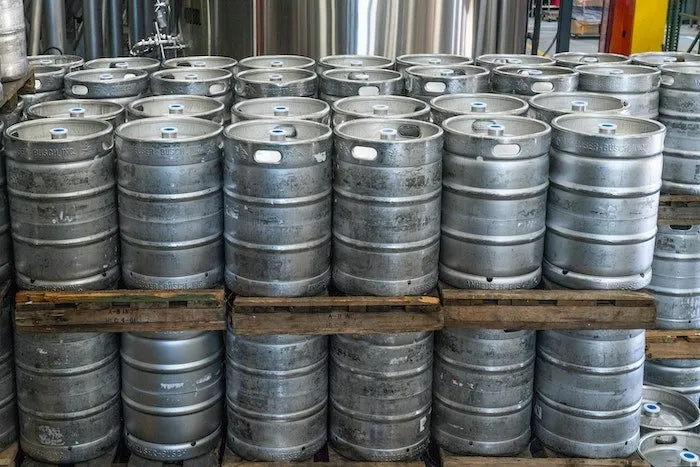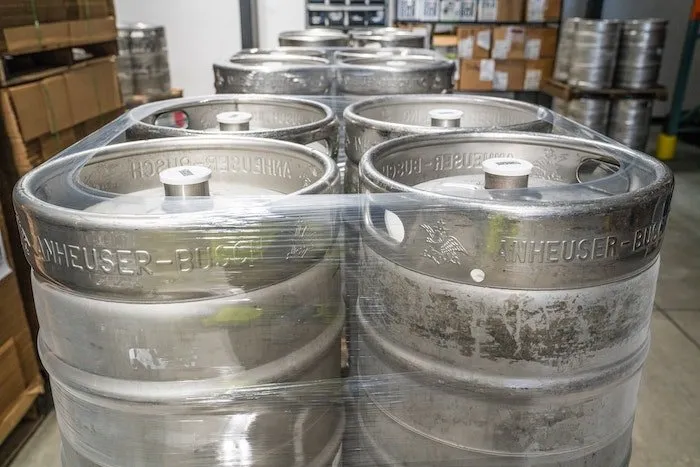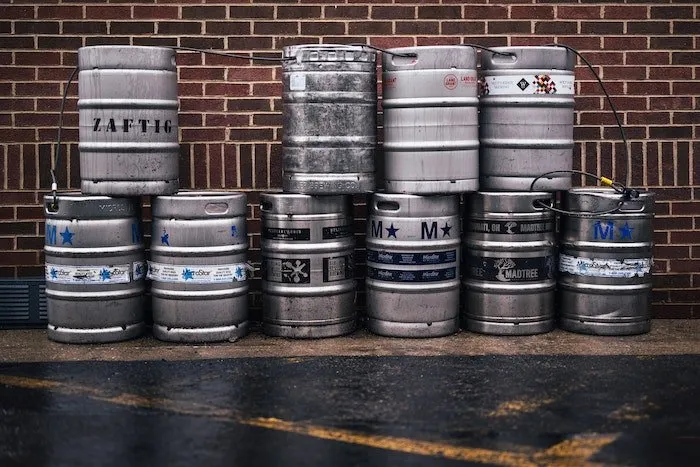Kegs are an essential part of any beer lover’s arsenal, but how long does an untapped keg last? It turns out that the shelf life of a keg depends on several factors such as storage and cleaning. Knowing the right way to store, clean and tap your untapped kegs is key in making sure you get the most bang for your buck when it comes to freshness and flavor.
In this blog post we’ll explore what you need to know about storing, sanitizing, tapping and troubleshooting common issues with untapped kegs so that they can be enjoyed at their peak potential – all while helping answer our initial question: How long does an untapped keg last?
Table of Contents:
- Storage of Untapped Kegs
- Shelf Life of Untapped Kegs
- Cleaning and Sanitizing Kegs Before Use
- Tapping an Untapped Keg
- Troubleshooting Common Issues with Untapped Kegs
- FAQs in Relation to How Long Does an Untapped Keg Last
- Conclusion
Storage of Untapped Kegs

When it comes to storing untapped kegs, there are three main factors that should be taken into consideration: temperature, humidity, and light exposure.
Temperature is one of the most important factors when it comes to storing beer in a keg. It’s best to store your beer at temperatures between 40-55°F (4-13°C). Storing your beer at higher temperatures can cause off flavors and spoilage due to accelerated oxidation. Lower temperatures can also cause problems such as slow carbonation or yeast flocculation.
Humidity levels should also be monitored when storing untapped kegs. Too much moisture in the air can lead to mold growth on the inside of the keg which will contaminate your beer and make it undrinkable. The ideal relative humidity for storage is between 50-70%. If you live in an area with high humidity levels, consider investing in a dehumidifier for your storage space.
Beer stored in clear or green glass containers are especially vulnerable since they allow more light through than darker bottles or cans do. Ultraviolet (UV) rays from sunlight can react with certain compounds found in hops and create skunky aromas and flavors that ruin the taste of your brews, so it is best to keep them out of direct sunlight if possible.
Proper storage of untapped kegs is essential for maintaining the quality and flavor of your beer. Temperature, humidity, and light exposure are all important factors that should be taken into consideration when storing an untapped keg. Now let’s look at how long these kegs can last in optimal conditions.
Shelf Life of Untapped Kegs
The shelf life of an untapped keg depends on a variety of factors, including the type of beer and storage conditions. Generally speaking, beers with higher alcohol content have longer shelf lives than those with lower alcohol content. Lagers tend to last longer than ales due to their slower fermentation process. Additionally, storing your kegs in a cool, dark place will help them stay fresher for longer periods of time.
When it comes to recommended storage times for different types of beer, lagers can typically be stored for up to three months while ales should be consumed within two months. Beers with higher alcohol contents such as stouts or barley wines can last up to six months when properly stored. It is important to note that these are just general guidelines and some beers may need to be consumed sooner depending on their ingredients and production methods.
By following these simple steps, you can maximize the shelf life of your untapped kegs: keep them away from direct sunlight; store at temperatures between 40-60°F (4-15°C); use clean equipment when transferring beer into the keg; purge oxygen from the headspace before sealing; ensure proper carbonation levels; and store upright rather than laying down flat or sideways. This will help ensure that your beer stays fresh until you are ready to enjoy it.
It’s important to understand the shelf life of untapped kegs, as well as how to properly clean and sanitize them before use, in order to ensure that your beer tastes great. Let’s take a look at how to do just that.
Cleaning and Sanitizing Kegs Before Use
Cleaning and sanitizing kegs before use is an important step in ensuring that the beer you serve is of the highest quality. In order to do this properly, there are a few supplies and equipment that you will need.
Necessary Supplies and Equipment
The necessary supplies for cleaning and sanitizing kegs include a cleaning brush, a hose with pressure washer attachment, cleaning solution (such as PBW or Oxyclean), sanitizer (such as Star San or Iodophor), hot water, paper towels, rubber gloves, and safety glasses. You may also want to have a thermometer on hand to check the temperature of your solutions.
Step-by-Step Instructions for Cleaning and Sanitizing Kegs
Once finished, rinse out one more time with cold water. Then move onto the sanitation process by filling up half way again but this time adding 1 tablespoon per gallon used instead along with 2 tablespoons citric acid if desired which helps prevent staining due to oxidation when exposed air gets into contact with beer during storage periods between uses. Let stand for 10 minutes before draining completely once more through same methods previously discussed earlier so now we can finally say our job here is done
Properly cleaning and sanitizing a keg before use is essential for ensuring the quality of beer, as well as the longevity of the keg. Now that your kegs are ready to go, let’s look at how to tap an untapped keg.
Tapping an Untapped Keg

Necessary Supplies and Equipment
Tapping an untapped keg requires a few supplies and equipment, including a CO2 tank, regulator, beer line, faucet assembly, shank assembly with washer and nut, hex key wrench or screwdriver (depending on the type of nut used), and keg coupler. It is important to make sure all these components are in good working order before attempting to tap the keg.
Step-by-Step Instructions for Tapping an Untapped Keg
Finally, attach one end of your beer line onto this shank assembly making sure everything is tight enough but not too tight so as not to damage any parts while doing so. Then take off the protective cap from the bottom side of the keg coupler followed by attaching the other end onto the tapped side of the keg itself, pushing down firmly until you hear a click sound indicating it is locked into place correctly and now ready for pouring cold delicious beers.
Once you’ve tapped an untapped keg, it’s important to make sure the beer is served correctly. If any issues arise while serving the beer, troubleshooting common problems can help ensure a great tasting experience for everyone!
Troubleshooting Common Issues with Untapped Kegs
Foaming Beer or Low Pressure Problems. Foaming beer or low pressure problems are common issues that can occur when using an untapped keg. This is usually caused by a lack of carbonation in the beer, which can be remedied by increasing the amount of CO2 being injected into the keg. If this doesn’t work, it could also be due to a faulty regulator or improper temperature settings on your draft system. To fix this issue, make sure all components of your draft system are working properly and adjust the temperature accordingly.
Off Flavors or Cloudy Beer. Off flavors and cloudy beer can often occur with untapped kegs if they have not been stored correctly. Make sure you store your kegs at proper temperatures (around 40-45°F) and keep them away from direct sunlight as much as possible to avoid any off flavors developing in your beer. Additionally, ensure that you clean and sanitize all equipment before use to prevent any bacteria from getting into the beer during transfer or storage processes.
If adjusting the regulator settings does not solve the issue, then it may be necessary to replace some parts such as o-rings and seals, depending on what type of tap system is installed on your keg(s).
FAQs in Relation to How Long Does an Untapped Keg Last
How long do kegs last if not tapped?
Kegs can last for a long time if not tapped, depending on the type of beer and how it is stored. Generally, unopened kegs will remain fresh for up to 6 months when stored in a cool, dark place. Once opened, however, the shelf life of a keg depends on how quickly it is consumed; most beers will stay fresh for about two weeks after tapping. To maximize shelf life and taste quality, make sure to keep your keg cold at all times and avoid exposing it to light or heat.
Do kegs go bad if untapped?
Yes, kegs can go bad if left untapped. The carbon dioxide that is used to pressurize the beer will eventually dissipate, resulting in flat and stale beer. Additionally, leaving a keg untapped for an extended period of time can lead to oxidation which further affects the taste and quality of the beer. To ensure freshness and flavor, it’s best to tap your keg as soon as possible after purchase or delivery.
Do untapped kegs need to be refrigerated?
Yes, untapped kegs need to be refrigerated. This is because beer contains yeast which will continue to ferment in the keg if not stored at a cold temperature. If left unrefrigerated, the beer can become over-carbonated and taste sour or off. Additionally, leaving a keg out of refrigeration for too long can cause bacteria growth that could make you sick if consumed. To ensure your beer stays fresh and safe to drink, always store it in a refrigerator until ready for use.
How can you tell if keg beer is bad?
Keg beer can go bad if it is not stored and served properly. To tell if keg beer has gone bad, you should look for signs such as off-flavors, cloudy appearance, or a sour smell. Additionally, check the expiration date on the keg to ensure that it hasn’t passed its shelf life. If you are unsure of whether your keg beer is still good or not, it’s best to discard it and purchase a new one.
Conclusion
In conclusion, it is important to understand the shelf life of an untapped keg and how to properly store and clean them before use. With proper storage and maintenance, a keg can last up to 6 months or more depending on the beer type.
It is also essential to know how to tap an untapped keg correctly in order for it to stay fresh for as long as possible. If you ever experience any issues with your untapped keg, troubleshooting common problems can help ensure that your beer stays fresh for as long as possible. Knowing all this information will help answer the question: How long does an untapped keg last?
Are you looking for the best way to keep your beer fresh and tasty? Have you ever wondered how long an untapped keg can last without losing its flavor or carbonation? Look no further! Our blog provides all of the information, advice, tips, and reviews needed to make sure that your next batch of brew is perfect every time. From detailed equipment breakdowns to subscription services for keeping a steady supply on hand – we have it all covered.
Join us as we explore everything related to craft beers so that you can enjoy each sip with confidence!
